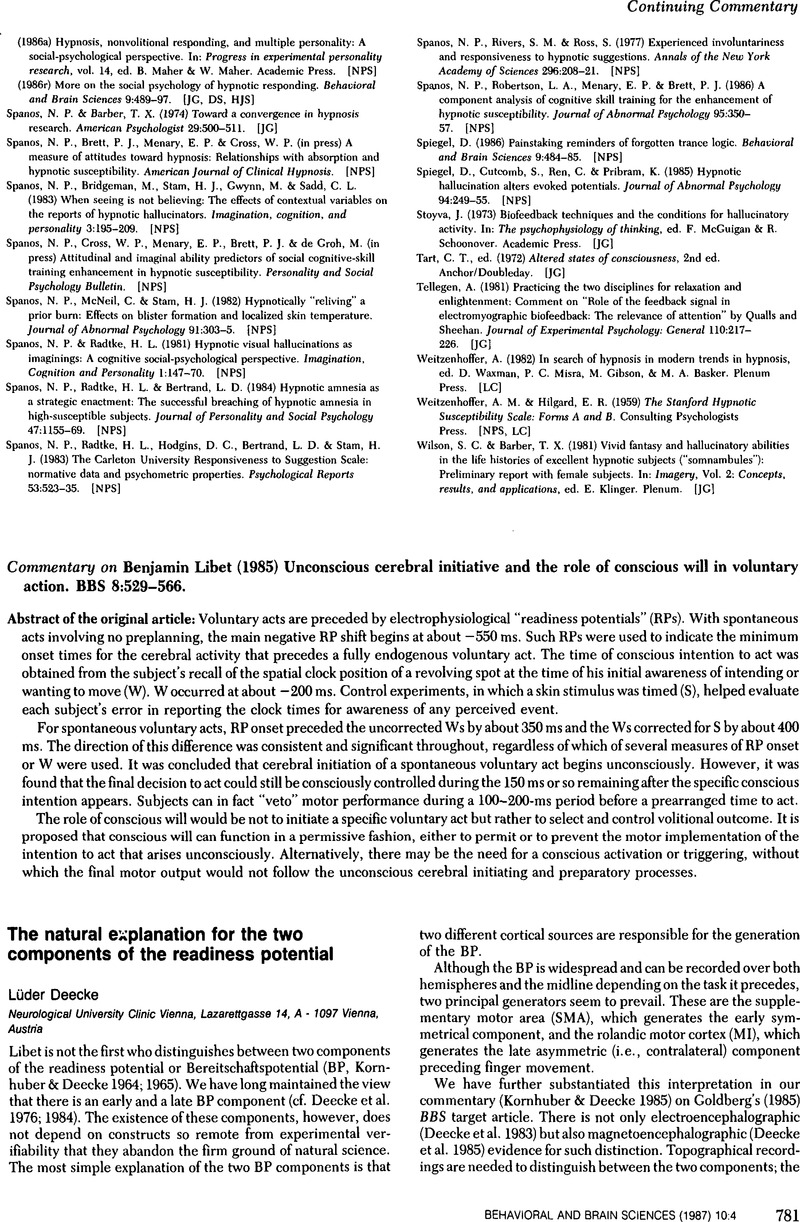Crossref Citations
This article has been cited by the following publications. This list is generated based on data provided by Crossref.
Brown, Jason W
1989.
The nature of voluntary action.
Brain and Cognition,
Vol. 10,
Issue. 1,
p.
105.
Dennett, Daniel C.
and
Kinsbourne, Marcel
1992.
Escape from the Cartesian Theater.
Behavioral and Brain Sciences,
Vol. 15,
Issue. 2,
p.
234.
Gregson, Robert A. M.
1992.
Nothing is instantaneous, even in sensation.
Behavioral and Brain Sciences,
Vol. 15,
Issue. 2,
p.
210.
Glymour, Bruce
Grush, Rick
Hardcastle, Valerie Gray
Keeley, Brian
Ramsey, Joe
Shagrir, Oron
and
Watson, Ellen
1992.
The Cartesian Theater stance.
Behavioral and Brain Sciences,
Vol. 15,
Issue. 2,
p.
209.
Wasserman, Gerald S.
1992.
The psychoanatomy of consciousness: Neural integration occurs in single cells.
Behavioral and Brain Sciences,
Vol. 15,
Issue. 2,
p.
232.
Clark, Andy
1992.
Experiential facts?.
Behavioral and Brain Sciences,
Vol. 15,
Issue. 2,
p.
207.
Hurley, S. L.
1992.
Some mistakes about consciousness and their motivation.
Behavioral and Brain Sciences,
Vol. 15,
Issue. 2,
p.
211.
Lycan, William G.
1992.
UnCartesian materialism and Lockean introspection.
Behavioral and Brain Sciences,
Vol. 15,
Issue. 2,
p.
216.
Baars, Bernard J.
and
Fehling, Michael
1992.
Consciousness is associated with centralas well asdistributed processes.
Behavioral and Brain Sciences,
Vol. 15,
Issue. 2,
p.
203.
Velmans, Max
1992.
Is consciousness integrated?.
Behavioral and Brain Sciences,
Vol. 15,
Issue. 2,
p.
229.
Damasio, Antonio R.
1992.
The selfless consciousness.
Behavioral and Brain Sciences,
Vol. 15,
Issue. 2,
p.
208.
Aronson, J.
Dietrich, E.
and
Way, E.
1992.
Throwing the conscious baby out with the Cartesian bath water.
Behavioral and Brain Sciences,
Vol. 15,
Issue. 2,
p.
202.
Reingold, Eyal M.
1992.
Conscious versus unconscious processes: Are they qualitatively different?.
Behavioral and Brain Sciences,
Vol. 15,
Issue. 2,
p.
218.
Jeannerod, M.
1992.
The where in the brain determines the when in the mind.
Behavioral and Brain Sciences,
Vol. 15,
Issue. 2,
p.
212.
McDermott, Drew
1992.
Little “me”.
Behavioral and Brain Sciences,
Vol. 15,
Issue. 2,
p.
217.
Rollins, Mark
1992.
Content and conformation: Isomorphism in the neural sway.
Behavioral and Brain Sciences,
Vol. 15,
Issue. 2,
p.
219.
Block, Ned
1992.
Begging the question against phenomenal consciousness.
Behavioral and Brain Sciences,
Vol. 15,
Issue. 2,
p.
205.
Farah, Martha J.
1992.
The distributed pineal gland.
Behavioral and Brain Sciences,
Vol. 15,
Issue. 2,
p.
209.
Roskies, Adina L.
and
Wood, C. C.
1992.
Cinema 1-2-Many of the Mind.
Behavioral and Brain Sciences,
Vol. 15,
Issue. 2,
p.
221.
Rosenthal, David M.
1992.
Time and consciousness.
Behavioral and Brain Sciences,
Vol. 15,
Issue. 2,
p.
220.



